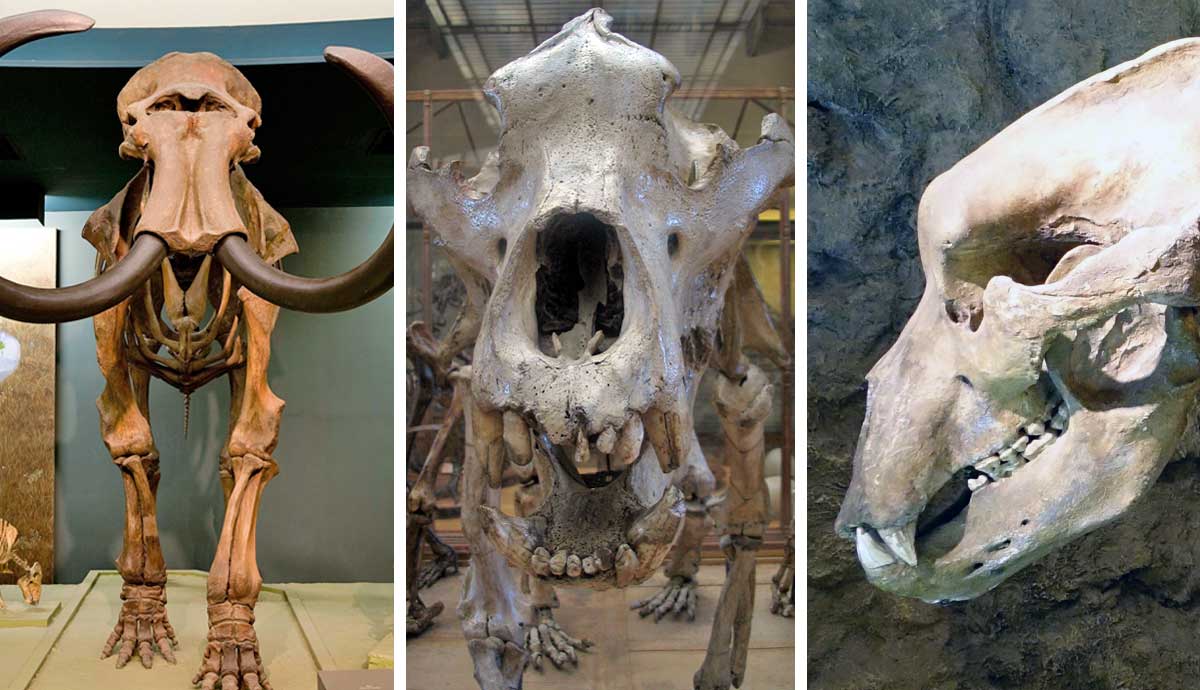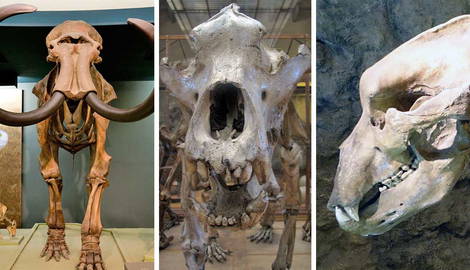
Scientists have recorded five Ice Ages in Earth’s history. The most recent began around three million years ago and continues today. Ice ages are characterized by glacial periods, where the climate is colder and glaciers advance, and interglacial periods, where the climate is milder and glaciers retreat. The last glaciation period concluded 11,000 years ago at the end of the Pleistocene, an epoch often considered synonymous with the current ice age, and caused the mass extinction of almost 200 species of megafauna in 50,000 years. Meet seven of the enormous mammals that once walked the Earth but went extinct during our current Ice Age.
1. The Woolly Mammoth (Mammuthus primigenius)

Perhaps one of the most well-known species on the list is the woolly mammoth, which was once believed to have died out at the end of the last glaciation. That was until paleontologists discovered an isolated population on Wrangel Island in the Russian Arctic that survived until just 4,000 years ago. The mammoths belonged to the family Elephantidae, as they diverged from the elephant lineage around seven million years ago in Africa. Woolly mammoths evolved from the steppe mammoth (Mammuthus trogontherii) around 800,000 years ago in Siberia before traveling across Europe and Asia and into North America.

After surviving drastic climatic changes across the Northern Hemisphere for over half a million years, a warming climate, human hunting, and rising sea levels led to the isolation of one island population. The Wrangel Island mammoths survived a further 6,000 years and have been cited as an example of mutational meltdown, in which deleterious mutations that increase the risk of disease accumulate in a small population. However, despite the population reducing to just eight breeding individuals, evidence shows that the population remained stable for generations. Researchers suspect a sudden event caused the species’ eventual demise, such as a disease outbreak or rapid environmental changes.
To resurrect the woolly mammoth to the Arctic tundra, Colossal Biosciences developed a “de-extinction” project to genetically modify Asian elephants using preserved mammoth DNA. Like other large herbivores, woolly mammoths played a crucial role in their ecosystem, maintaining grasslands as they trampled the landscape, dispersed seeds, and supported nutrient-rich soils with their dung. Scientists have argued that introducing genetically engineered elephants would protect the Arctic permafrost, an important carbon reservoir. However, many scientists and conservationists have raised concerns about how we prioritize conservation projects and species, as well as the ethics and welfare risks involved.
2. The Saber-Toothed Tiger (Smilodon)

The saber-toothed tiger, a bulky member of the cat family (Felidae), was a large carnivorous mammal with elongated blade-like canines. Three species of the genus Smilodon are currently known. The largest of the three, and of all known felids, was Smilodon populator, weighing up to 400 kg. Comparatively, Smilodon fatalis was proportional to a Siberian tiger, while the smallest of the three, Smilodon gracilis, had a body mass akin to a jaguar. A great deal of our knowledge on the species was gained from specimens preserved in the Rancho La Brea Tar Pits of Los Angeles, California. Tar pits, or asphalt seeps, are considered “carnivore traps” due to the abundance of carnivorous mammals attracted by, and consequently immobilized alongside, their herbivorous prey.

Saber teeth are a textbook example of convergent evolution in which distantly related organisms independently evolve similar features, often to adapt to similar problems. This specialized tooth morphology has evolved multiple times across mammalian history, first appearing 265 million years ago in the Gorgonopsians, a stem mammal with a reptile-like appearance. Using 3D digitization, researchers predicted how Smilodon utilized its iconic teeth, finding this dental characteristic to be adapted for killing large prey found across North and South America. Due to the fragility of their long fangs, the ambush predator would deliver a swift puncturing bite to the softer parts of their kill.
Paleontologists have speculated that saber teeth contributed to the extinction of Smilodon around 10,000 years ago. Their specialized teeth hindered their ability to cope with the changing climate as suitable prey became sparser and human presence increased competition for food. However, as dental wear analysis shows no evidence of scavenging behavior, which would be expected during a period of increased competition, this theory is up for debate.
3. The Cave Bear (Ursus spelaeus)

The cave bear, an extinct relative of the brown bear (Ursus arctos), was once widespread across Europe and Asia. While their coat resembled a brown bear’s, their large body mass rivaled the weight of a polar bear. As their name would suggest, cave bears frequented caves and used the sites for purposes beyond hibernation. Before the species was described in 1794, their bones were believed to have belonged to many creatures, including dragons, unicorns, lions, and polar bears. Deposits of their bones are found in many caves and are often well-preserved. In fact, during World War I, cave sediments where cave bear remains occurred were mined for phosphate to use in fertilizers and explosives.

While declining temperatures likely contributed to the extinction of the cave bear 25,000 years ago, the stability of populations during cold periods and beyond the Arctic Circle implies there is more to the story. Genomic research revealed that the cave bear suffered a population decline around 40,000 years ago, nearing the period when anatomically modern humans began to spread across Europe. Dependent on caves for hibernation, it is thought that the species competed for shelter, particularly given their tendency to return to their birth cave. This behavior, known as “homing,” would have made the cave bear a predictable target, vulnerable to the advanced hunting techniques of humans.
4. The Dire Wolf (Aenocyon dirus)

Much like the cave bear, remains of the extinct dire wolf are abundant, with over 4,000 individuals excavated from the La Brea Tar Pits alone. Dire wolves diverged from living canids nearly 5.6 million years ago and evolved in isolation from other lineages. Found across the Americas, this iconic predator was the most prevalent Pleistocene canid in North America. While they bore a resemblance to the gray wolf (Canis lupus), dire wolves were suited to killing large prey, displaying a more robust skull and frame, a greater bite force, and large canines.

Despite the rich fossil record of the dire wolf, there is little consensus on what drove their extinction 13,000 years ago, particularly given the survival of gray wolves and coyotes through the Late Pleistocene extinctions. One theory is that when large herbivorous species died out, the dire wolf could not adapt to smaller prey to maintain a high calorific intake. It is proposed that while gray wolves and coyotes (Canis latrans) were able to hybridize, reproductive isolation prevented the dire wolves from acquiring traits such as enhanced immunity to new diseases.
Colossal Biosciences, which has several “de-extinction” projects in the works, announced the arrival of three dire wolf pups brought to life in October 2024. The gray wolf, which belongs to a separate genus, was genetically engineered to display similar physical traits to the extinct dire wolf. Conservationists have warned people against viewing these projects as solutions to extinction, as Colossal has framed the project, and argue that we should be fighting to conserve species rather than attempting to resurrect them.
5. The Giant Ground Sloth (Megatherium americanum)

Belonging to the genus Megatherium, “great beast,” Megatherium americanum was the first and most well-known species of giant ground sloth. Most fossil evidence comes from the Pampas grassy plains of Argentina, but the species also lived at lower elevations east of the Andes, including parts of Bolivia, Uruguay, Paraguay, and Brazil. Despite weighing up to 4,000 kilograms, fossil footprints indicate that these 6-meter-long sloths could adopt a bipedal posture, allowing them to reach high-growing foliage.
As excellent seed dispersers, the herbivorous Megatherium americanum could swallow fruits whole, carry the seeds in their digestive tract, and defecate them far away. In fact, the extinct sloth is celebrated for its role in preserving and dispersing the well-loved avocado fruit. As a result, their extinction likely led to a reduction in the diversity and density of forests.

Evidence of cut marks on the bones of extinct sloths, fossilized footprints, and prehistoric depictions of hunting scenes indicates that early hunter-gatherers once coexisted with giant ground sloths. Early human groups, who arrived in South America some 20,000 years ago, hunted the sloths for their meat and bones. Megatherium became extinct at the start of the Holocene Epoch around 10,000 years ago, along with many megafauna in South America, presumably due to a combination of human activity and climatic fluctuations.
6. The Giant Beaver (Castoroides)

Equal in size to a black bear (Ursus americanus), the two-meter-long giant beaver was the largest rodent to have lived in North America, weighing up to a hefty 100 kilograms. The genus comprised two species: Castoroides dilophidus, restricted to southeastern states, and Castoroides ohioensis, found in the continental United States and Canada. Giant beavers were distant relatives of the modern beavers seen today, sharing a common ancestor nearly two million years ago. While the two shared a similar habitat, the extinct beaver had a proportionally smaller brain and would have displayed much less complex behavioral patterns.

The semi-aquatic giant beaver lived on land and in water, consuming a diet of aquatic vegetation. Some researchers have proposed that their diet included foliage and trees, and believe they practiced similar tree harvesting behaviors to modern beavers. However, this hypothesis has been largely disputed due to a lack of evidence of dams or lodges constructed by giant beavers and their lack of protruding or chisel-shaped incisors.
Paleontologists have theorized that one contributing factor to the survival of the Eurasian (Castor fiber) and North American beavers (Castor canadensis) was their ability to customize their habitats. Affectionately known as “ecosystem engineers,” these extant beavers could endure the loss of wetlands caused by increasingly warm, dry conditions 10,000 years ago by building dams and lodges. Reduced to an isolated population south of the Great Lakes, the giant beaver later became extinct due to the changing climate and competitive habitat.
7. The Giant Short-Faced Kangaroo (Procoptodon goliah)

Last in the list is Procoptodon goliah, an extinct sthenurine, or short-faced kangaroo, that inhabited semiarid areas in South Australia and New South Wales. The species reached an astonishing two meters and 230 kilograms, making it not only the largest of its genus, but of all known kangaroos. On each of their hind feet was a single toe with a hoof-like claw, similar to a horse. These broad digits stabilized the stocky animal, allowing them to travel long distances through open plains. While one might imagine these large kangaroos hopping as their modern counterparts would, anatomical evidence indicates that Procoptodon goliah moved by walking, using its tail and digits to stabilize.

By the end of the late Pleistocene, an estimated 90% of Australia’s megafauna were driven to extinction, including more than 40 species of kangaroo. The genus Procoptodon is believed to have gone extinct by 45,000 years ago, though fossil evidence indicates some species persisted until about 15,000 years ago. Land-burning by humans has been proposed as an explanation, causing less nutritious plants to replace fire-sensitive vegetation. However, this theory is largely refuted as Procoptodon goliah browsed on less-flammable plants such as saltbush. Given that the species endured multiple arid periods, hypotheses involving droughts have been similarly contested.
Due to its saltbush diet, Procoptodon goliah relied on free-standing water, making it a vulnerable target to humans occupying the same water sources. Traveling across open shrublands, grasping branches with its long claws, the giant kangaroo would have been highly visible. While there is no evidence that the animal was hunted, the arrival of humans in Australia 50,000 years ago correlates closely with the extinction of the species. It is likely that human interference, in combination with climatic shifts, led to their disappearance.










